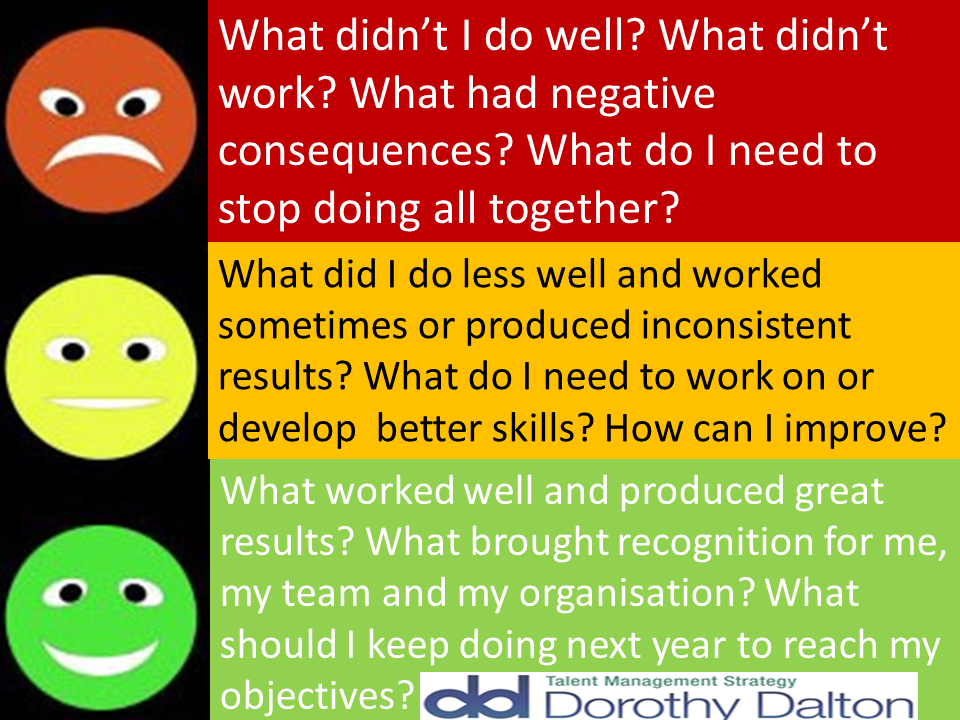Today we will be inundated with posts about goal setting and New year’s resolutions. It’s well recorded that I’m not a fan of New Year’s resolutions especially when it comes to career goals. “In one year and out the next” is pretty accurate way to describe the process. I’ve long favoured manageable, achievable goals which spur us on to more challenging things. One way to avoid that is via the traffic light coaching exercise. This is a great drill and can be used for personal assessment or even for your team. It’s simple and easy to apply with exactly the same principles as the highway code.
Any goals should be ongoing and not just made at a random time of the year because everyone else is on the bandwagon. And more than once a year at that. Most New Year’s resolutions fizzle out almost as fast as the New Year bubbly, which is why gyms are rammed in January and only half full in March. What I do encourage anyone as part of their regular career management exercises is to review their year retrospectively. I’ve even read that a goal isn’t a goal unless it’s painful. To be effective, goals need to be chosen wisely and pursued systematically and consistently, rather than with a flurry of enthusiasm in January. This is not to be confused with challenge or discomfort. If your language is peppered with “Stop, no more, lose, reduce, limit, fix” you are probably setting yourself up for sure failure. Having goals isn’t about being a suffering martyr!
This is why the traffic light coaching exercise works. It incorporates what you already do well and gives you a factual base on which to make a plan.
Traffic light coaching
Green light
I like to start with green and positive affirmation of achievements during the past year. I’ve found no one gets very far if they begin by berating themselves for things that didn’t go to plan and putting themselves down. it’s also more fun. The green light in all traffic systems everywhere is a signal to go and move forward. We even use it on an everyday level. if someone has a “green light.” it tells is that they have the go-ahead. Inbuilt into this phrase, is the assumption that it is safe to do so. It means that we have taken all the necessary precautions or carried out a risk evaluation before we shift gears. It assumes that we have paid attention to any potential warnings: parked cars, pedestrians, and any other hazards such as bad drivers – not you of course.
The same is true for your career. Look at what you have done well in 2017, and which actions have helped you reach your goals. It means being observant and mindful of your successes and analysing how they happened and how those methods can be applied in the up coming year. It’s about owning and articulating your accomplishments and valuing your transferable skills. You would be surprised how many people struggle with this process. Congratulate and reward yourself for a job well done. It’s popular to say there’s no “I” in team – but there is an “i” in fired. We are all accountable and responsible for reaching our goals and objectives.
Amber light
An amber light is the signal to slow down. It’s time to listen to those around you, to be present in what you are doing and understanding the more nuanced areas of your performance in your job and even your life. What do you do that produces inconsistent results – sometime good, sometimes less great? Why is that? Evaluate your activities strategically. You might have identified that you are a great networker but there comes a point where you have reached diminishing returns. Can your time and investment be better deployed elsewhere? Examine what are you doing less well and work out a plan to improve. Create a personal development plan for the upcoming year. Research options and formulate a budget. Even though some organisations are cutting back on training, many are willing to invest in competence coaching for employees. Career coaching is also frequently funded by organisations. Perhaps this is the time to look for a mentor, someone who can give you neutral feedback.
Red light
This makes us look at what we need to stop doing and to be realistic about why something didn’t go as planned. It’s a time to examine habits we may have fallen into, and own the ones that are counter-productive. It might be spending too much time on social media or being too detail focused or not paying enough attention to the small things that matter. It can be about your communication style. Ask your team or peers for feedback. What do they think your red light areas are? Take a look at your relationships – are there any that have become toxic? The approach is to focus on positive actions and not negative ones.
Traffic light coaching make helps you carry out an analysis of the key elements of your professional life and makes it easier to see the bigger picture. The process is about understanding the present, making an evaluation, opening your mind to new ideas and commiting to change. Then making that change happen. Maybe you’ve out grown your job and need to move on. Perhaps your organisation is great, but you need a bigger challenge.
So instead of agonising over possibly unrealistic resolutions and beating yourself up for not following through, try this simple traffic light coaching exercise and see how you get on.
Need career coaching support – contact me.







FIFA brought together the players, plus six young referees representing the confederations, to help develop their leadership skills both on the field and off it.